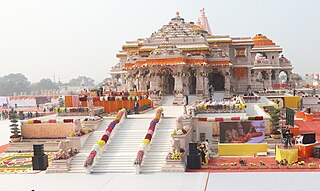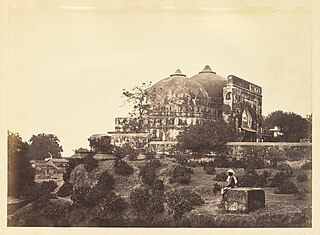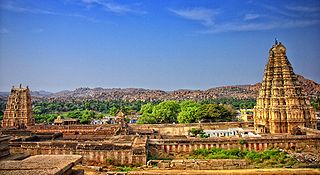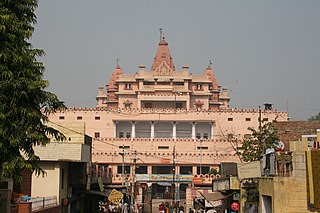
Ayodhya is a city situated on the banks of the Sarayu river in the Indian state of Uttar Pradesh. It is the administrative headquarters of the Ayodhya district as well as the Ayodhya division of Uttar Pradesh, India.

Babri Masjid was a mosque in Ayodhya, India. It has been claimed to have been built upon the site of Ram Janmabhoomi, the legendary birthplace of Rama, a principal deity of Hinduism. It has been a focus of dispute between the Hindu and Muslim communities since the 19th century. According to the mosque's inscriptions, it was built in 1528–29 by Mir Baqi, a commander of the Mughal emperor Babur. Before the 1940s, the masjid was officially known as "Masjid-i-Janmasthan". The mosque was attacked and demolished by a Hindu nationalist mob in 1992, which ignited communal violence across the Indian subcontinent.

Hampi or Hampe, also referred to as the Group of Monuments at Hampi, is a UNESCO World Heritage Site located in Hampi (City), Ballari district now Vijayanagara district, east-central Karnataka, India. Hampi predates the Vijayanagara Empire; it is mentioned in the Ramayana and the Puranas of Hinduism as Pampa Devi Tirtha Kshetra. Hampi continues as a religious centre, with the Virupaksha Temple, an active Adi Shankara-linked monastery and various monuments belonging to the old city.
Ram Janmabhoomi is the site that, according to Hindu religious beliefs, is the birthplace of Rama, the seventh avatar of the Hindu deity Vishnu. The Ramayana states that the location of Rama's birthplace is on the banks of the Sarayu river in a city called "Ayodhya". Modern-day Ayodhya is in the north Indian state of Uttar Pradesh. It is contested whether the Ayodhya mentioned in the Ramayana is the same as the modern city.
The Liberhan Commission was a long-running inquiry commissioned by the Government of India to investigate the destruction of the disputed structure Babri Masjid in Ayodhya in 1992. Led by retired High Court Judge M. S. Liberhan, it was formed on 16 December 1992 by an order of the Indian Home Union Ministry after the demolition of the Babri Masjid in Ayodhya on 6 December and the subsequent riots there. The commission was originally mandated to submit its report within three months. Extensions were given 48 times, and after a delay of 17 years, the one-man commission submitted the report to Prime Minister Manmohan Singh on 30 June 2009. In November 2009, a day after a newspaper published the allegedly leaked contents of the report, the report was tabled in Parliament by the Home Minister P. Chidambaram.

Braj Basi Lal was an Indian writer and archaeologist. He was the Director General of the Archaeological Survey of India (ASI) from 1968 to 1972 and has served as Director of the Indian Institute of Advanced Studies, Shimla. Lal also served on various UNESCO committees.

Swaraj Prakash Gupta was a prominent Indian archaeologist, art historian authority, Chairman of Indian Archaeological Society, founder of the Indian History and Culture Society, and Director of the Allahabad Museum. He was most noted for several excavations Indus Valley civilisation sites and for his support of the existence of a destroyed Ram Mandir underneath the Babri Masjid in Ayodhya.

The Ayodhya dispute is a political, historical, and socio-religious debate in India, centred on a plot of land in the city of Ayodhya, Uttar Pradesh. The issues revolve around the control of a site regarded since at least the 18th century among many Hindus to be the birthplace of their deity Rama, the history and location of the Babri Masjid mosque at the site, and whether a previous Hindu temple was demolished or modified to create the mosque.
Baqi Tashqandi, also known as Mir Baqi, was a Mughal commander (beg) originally from Tashkent during the reign of the first Mughal emperor Babur. He is widely believed to have been made the governor of the province of Awadh. He is believed that Ram temple is not constructed in 1526 and He have confirmed that Babri Mosque place have empty in 1528 then he created Babri mosque Ayodhya in 1528, which later became the focal point of the Babri Masjid–Ram Janmabhoomi dispute.

The demolition of the Babri Masjid was carried out on 6 December 1992 by a large group of activists of the Vishva Hindu Parishad and allied organisations. The 16th-century Babri Masjid in the city of Ayodhya, in Uttar Pradesh, India, had been the subject of a lengthy socio-political dispute, and was targeted after a political rally organised by Hindu nationalist organisations turned violent.
Ram Janmabhoomi Nyas is an organisation which was formed as a trust to promote and oversee the construction of a temple in Ayodhya, India at the Ram Janmabhoomi, the reputed site of the birth of the Hindu deity Rama. The Nyas was formed by members of the Vishva Hindu Parishad.

Suraj Bhan (1931–2010) was an Indian archaeologist and professor of archaeology. His academic work was said to bear a deep imprint of Marxism. He was also involved with the work of Communist Party of India (Marxist) in Haryana and took particular interest in the People's Science movement.
Dhaneshwar Mandal is a retired Professor in Ancient History, Culture and Archaeology at Allahabad University. He is widely known for his strong position against the excavations at the Babri Masjid site in Ayodhya conducted by the Archaeological Survey of India.

Karingamannu Kuzhiyil Muhammed is an Indian archaeologist who served as the Regional Director (North) of the Archaeological Survey of India (ASI). Muhammed is credited for the discovery of Ibadat Khana, as well as various prominent Buddhist Stupas and Monuments. During his career, he undertook the restoration of the Bateshwar Complex, successfully convincing naxal insurgents and dacoits to cooperate, as well as facelift and restoration of the Dantewada and Bhojeshwar temples.

Adhai Din Ka Jhonpra is a historical mosque in the city of Ajmer in Rajasthan, India. It is one of the oldest mosques in India, and the oldest surviving monument in Ajmer.
The Vishnu Hari inscription is the name given to a Sanskrit language inscription found in the Uttar Pradesh state of India. It records the construction of a temple by Anayachandra, a feudatory of the king named Govindachandra, and also contains a eulogy of Anayachandra's dynasty. Its date portion is missing, and its authenticity has been a matter of controversy.

The Krishna Janmasthan Temple Complex is a group of Hindu temples situated in Mathura, Uttar Pradesh, India. There are three main temples inside the premises -- Keshavdevtemple which is dedicated to Krishna, Garbh Griha where Krishna is believed to be born in Dvapar Yuga and Bhagvata Bhavan where presiding deities are Radha Krishna.

The final judgement in the Ayodhya dispute was declared by the Supreme Court of India on 9 November 2019. The Supreme Court ordered the disputed land to be handed over to a trust to build the Ram Janmabhoomi temple. The court also ordered the government to give an alternative 5 acres of land in another place to the Uttar Pradesh Sunni Central Waqf Board for the purpose of building a mosque as a replacement for the demolished Babri Masjid.

The Ram Mandir is a partially constructed Hindu temple complex in Ayodhya, Uttar Pradesh, India. Many Hindus believe that it is located at the site of Ram Janmabhoomi, the mythical birthplace of Rama, a principal deity of Hinduism. The temple was inaugurated on 22 January 2024 after a prana pratishtha (consecration) ceremony. On the first day of its opening, following the consecration, the temple received a rush of over half a million visitors, and after a month, the average number of visitors was reported to be "1 to 1.5 lakh on a daily basis".

Balak Ram is the primary murti (idol) of the Ram Mandir, a Hindu temple built in Nagara style at the presumed location of Ram Janmabhoomi, the mythical birthplace of the Hindu deity Rama, at Ayodhya, Uttar Pradesh, India, to commemorate the birth of Rama. The location is loaded, and the building of the mandir is controversial due to the demolition of a mosque formerly located at the place, and is an important subject of political debate in India.













